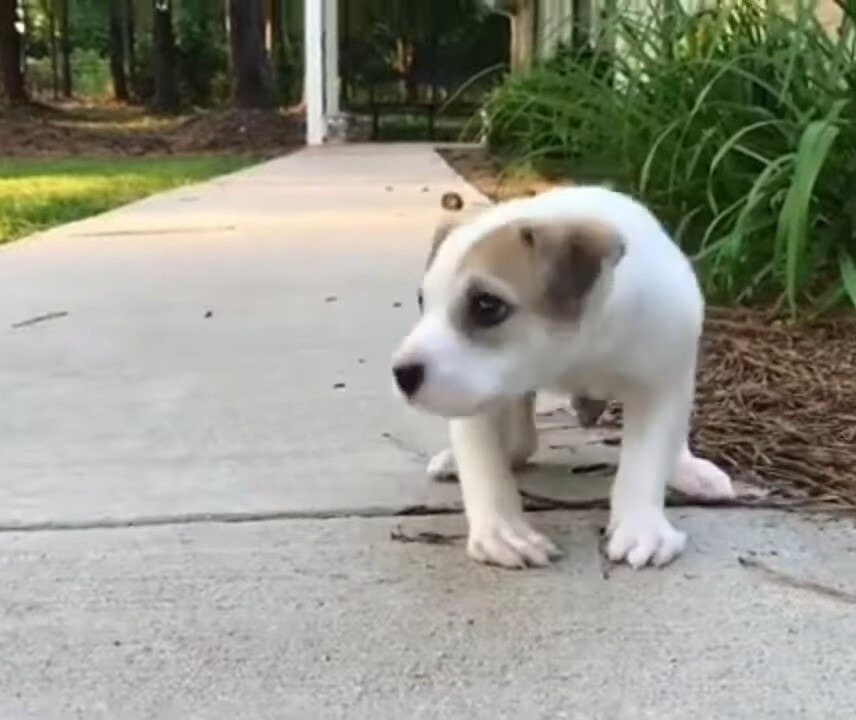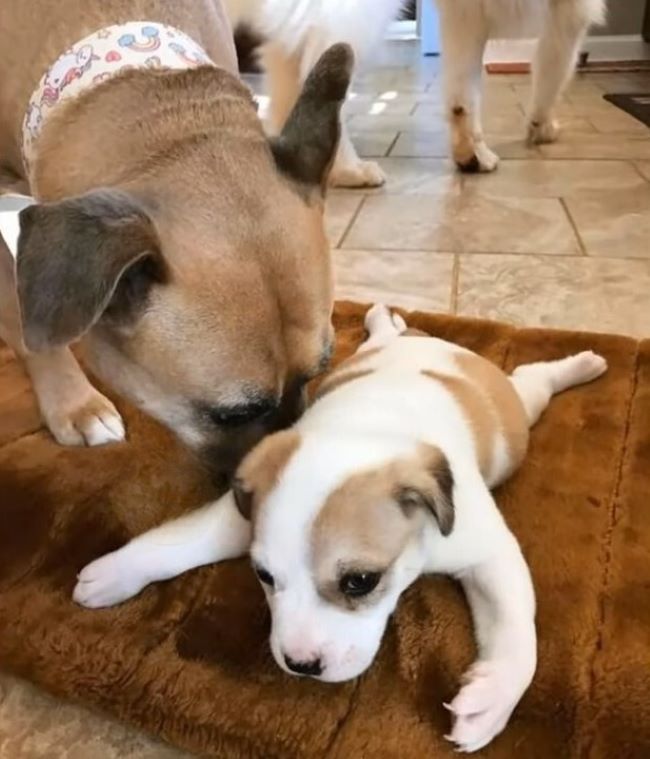It’s always incredibly sad to see how some newborn puppies are treated by their owners. While it’s rare, some of them are born with a deformity or develop a disability.
However, that is not any excuse to treat them like they’re worthless. Every puppy, regardless of his condition, has a lot of love to give, and the only thing they want is a chance to show it.
This poor dog was born with a deformed leg, which immediately meant that he was going to be rejected by his owners, so they cruelly left him on the streets.
However, things were not so gloomy for the pup, as his cries were heard by someone who wanted to help.
A Difficult Struggle
 Source: Animal Rescue
Source: Animal Rescue
They also had to take him to the Collier Animal Hospital in Georgia for a proper examination so they could determine how to treat his legs.
The vet consulted with other specialists in order to figure out treatment for his legs, and they came up with a viable therapy.
After a few days, it worked. The puppy, now named Creek, was showing a lot more movement in his front legs and his rescuer was working hard to help him as well.
Journey To A New Life

He was doing a lot better, but there was still a long way to go. They had to take him for another examination to see if they could come up with a better solution for one of his legs that was still a bit numb.
They decided to try out a new splint to help his leg move in the right direction. While there was no guarantee that it would work, it was worth the shot.
Creek was a lot happier now and was starting to change pretty fast. The therapy has done wonders for his condition, and it’s really amazing to see such a visible change in him.

His rescuer and the vets also thought it would be a good idea to wrap him up in order to train his hips and lower extremities to face in the proper direction.
Soon enough, Creek would make a new friend named Bosley. He was always so happy to play with him and his tail would wag constantly when the two were together.
After a little over a month of treatment, a kind woman from Georgia learned of Creek’s story and decided to adopt this adorable puppy herself.

She naturally continues his treatment and is updating his rescuers on his progress almost all the time. Even though he still wobbles, the improvement is astounding.
He is moving around a lot better now and is so determined to lead the life he always wanted. Thanks to his new family, that is now possible.
It’s really amazing to see how this innocent puppy was able to turn his situation around, thanks to his own perseverance and the help of some amazing people. I wish him and his family all the best.
If you’ve ever wondered about your furry friend’s cooling system, you’re not alone. Dogs, with their playful antics and loyal companionship, often leave us pondering the mysteries of their physiology. One common question that pops up is whether these four-legged pals sweat like we do. Understanding how dogs regulate their body temperature can shed light on their unique way of staying cool. As a seasoned dog trainer, you’re about to uncover the fascinating world of canine perspiration.
When it comes to sweating, humans have a well-known method of releasing heat through their skin. But what about dogs? The secret to their cooling mechanism lies beneath the surface, waiting to be explored. As you delve into this topic, you’ll gain valuable insights into how these lovable creatures keep their cool in the most intriguing ways. So, grab your leash and get ready to embark on a journey into the world of canine sweat – it’s a tale worth wagging about.
Understanding Canine Thermoregulation
Dogs regulate their body temperature differently than humans. Here’s how they do it:
- Limited Sweat Glands
Dogs have sweat glands, but not as many as humans. Most of their sweat glands are located in their paw pads, so they don’t cool down the same way we do through sweating. - Cooling Through Panting
Dogs primarily cool down by panting. As they breathe rapidly, moisture evaporates from their tongue, nasal passages, and lungs, helping lower their body temperature. - Seeking Shade and Water
Dogs instinctively find shade and water when they’re hot. They’ll rest in a cool spot and drink water to regulate their temperature. - Heat Release from Paws
Since dogs have sweat glands in their paw pads, they release some heat through their feet. You might notice their paw pads being damp when they’re hot. - Avoiding Overheating
Dogs are prone to overheating, especially brachycephalic breeds with short noses. It’s crucial to prevent overheating by keeping them cool in hot weather.
Understanding how dogs regulate their body temperature is essential for ensuring they stay comfortable and safe, especially during warm weather. Keep an eye on your furry friend and provide them with the necessary care to help them beat the heat.
The Role of Sweat Glands in Dogs
While dogs primarily cool themselves down through panting, did you know that they do have sweat glands? Unlike humans, who have sweat glands all over their bodies, dogs’ sweat glands are confined to specific areas, like their paw pads. These sweat glands play a minimal role in helping dogs regulate their body temperature.
Sweat glands in a dog’s paw pads are not as significant for cooling as they are in humans. Dogs rely on panting as their main method of cooling because their sweat glands are not as widespread. These glands in their paw pads release a small amount of moisture, but it’s not enough to effectively cool them down like in humans.
Since dogs don’t have an extensive network of sweat glands like humans do, their bodies have evolved different cooling mechanisms. While dogs can sweat a little from their paw pads, their primary ways of cooling down are through panting and seeking cooler areas like shade or water.
Understanding how dogs regulate their body temperature, including the limited role of sweat glands, is crucial for ensuring your furry friend’s comfort and safety, especially during hot weather. Keep an eye on your dog’s behavior in warm conditions and make sure they have access to shade and water to help them stay cool.
Cooling Mechanisms in Dogs
Dogs have different ways to cool themselves down when the temperature rises. Here are the primary cooling mechanisms that dogs use:
Panting
Dogs rely on panting as their main way to regulate body temperature. Through panting, they can release excess heat from their bodies, helping them cool down.
Seeking Shade
Finding a shaded area is instinctual for dogs when they feel overheated. Shade provides relief from direct sunlight and helps lower their body temperature.
Drinking Water
Drinking water is crucial for dogs to stay cool. Hydration aids in maintaining their body temperature, especially on hot days.
Limited Sweat Glands
Dogs have sweat glands, but they are not as numerous as humans’. The sweat glands in a dog’s paw pads play a minor role in cooling compared to panting.
Monitoring Behavior
Observing your dog’s behavior in warm weather is essential. Look out for signs of overheating, such as excessive panting or lethargy, and take immediate steps to cool them down.
Providing Access to Shade and Water
Ensuring that your dog has access to shade and water at all times is vital. This enables them to self-regulate their body temperature and prevent heat-related issues.
Understanding these cooling mechanisms in dogs is crucial for keeping your furry friend safe and comfortable, especially during hot weather. By being attentive to their needs and environment, you can help them stay cool and happy.
Factors Affecting Dogs’ Heat Tolerance
Fur Coat Length:
Shorter coats allow for better heat dissipation, whereas long and thick fur can trap heat, leading to increased body temperature.
Breed Characteristics:
Certain breeds, like Huskies and Malamutes, are better suited for cold climates due to their thick double coats, while brachycephalic breeds with flat faces, like Bulldogs, have more difficulty regulating their body temperature.
Activity Level:
Active dogs generate more body heat, requiring adequate cooling mechanisms to prevent overheating. Adjust activities during hot weather to prevent excessive heat buildup.
Age and Health Status:
Puppies and senior dogs are more vulnerable to heat stress due to their inability to regulate body temperature efficiently. Additionally, dogs with health conditions may have reduced heat tolerance.
Environmental Factors:
High humidity combined with heat can hinder a dog’s ability to cool down effectively, making it crucial to provide shaded areas and access to water to help them cope with the heat.
Outdoor Time:
Limit outdoor time during peak heat hours to prevent heat-related issues. Early mornings or evenings are ideal for walks and play to avoid overheating.
Inadequate Water Supply:
Ensure your dog has constant access to fresh water to prevent dehydration and assist in maintaining a regulated body temperature.
Obesity:
Overweight dogs are at higher risk of heat intolerance as excess fat can act as an insulator, impeding heat dissipation. Maintaining a healthy weight is essential for heat regulation.
Conclusion
So, there you have it – dogs have their unique ways of keeping cool without sweating. From panting to finding shade, they’ve got it covered. Remember to keep an eye on your furry friend during hot days and make sure they have shade and water. Factors like their fur length, breed, and age play a role in how they handle the heat. By understanding these factors, you can help your dog stay comfortable and avoid overheating issues. So, next time you see your pup panting away, know that it’s their way of staying cool in the heat.
Frequently Asked Questions
How do dogs regulate their body temperature?
Dogs regulate their body temperature through panting, seeking shade, and staying hydrated.
Why is it important to monitor dogs for signs of overheating?
Monitoring dogs for signs of overheating is crucial to prevent heat-related issues and ensure their well-being.
What factors affect dogs’ heat tolerance?
Factors affecting dogs’ heat tolerance include fur coat length, breed characteristics, activity level, age, health status, environmental factors, outdoor time management, water supply, and obesity.
[no_toc]

Hey there, I’m Janet Brooks, a dog-loving student from California. I’m all about helping pups in need, especially those without homes. Me and my awesome friends work together to give shelter and love to stray dogs. Oh, and I also write blogs about dogs to share helpful info.